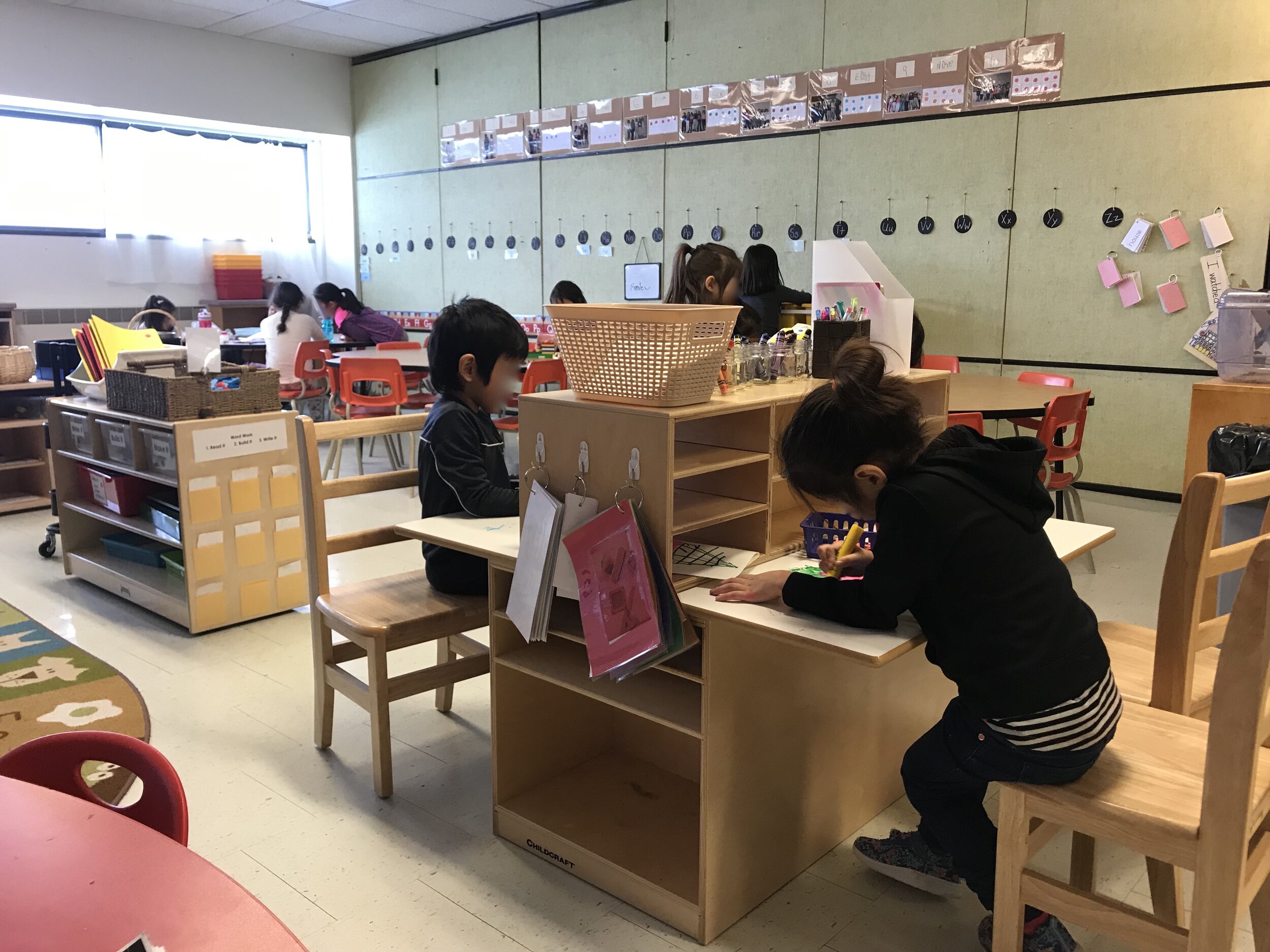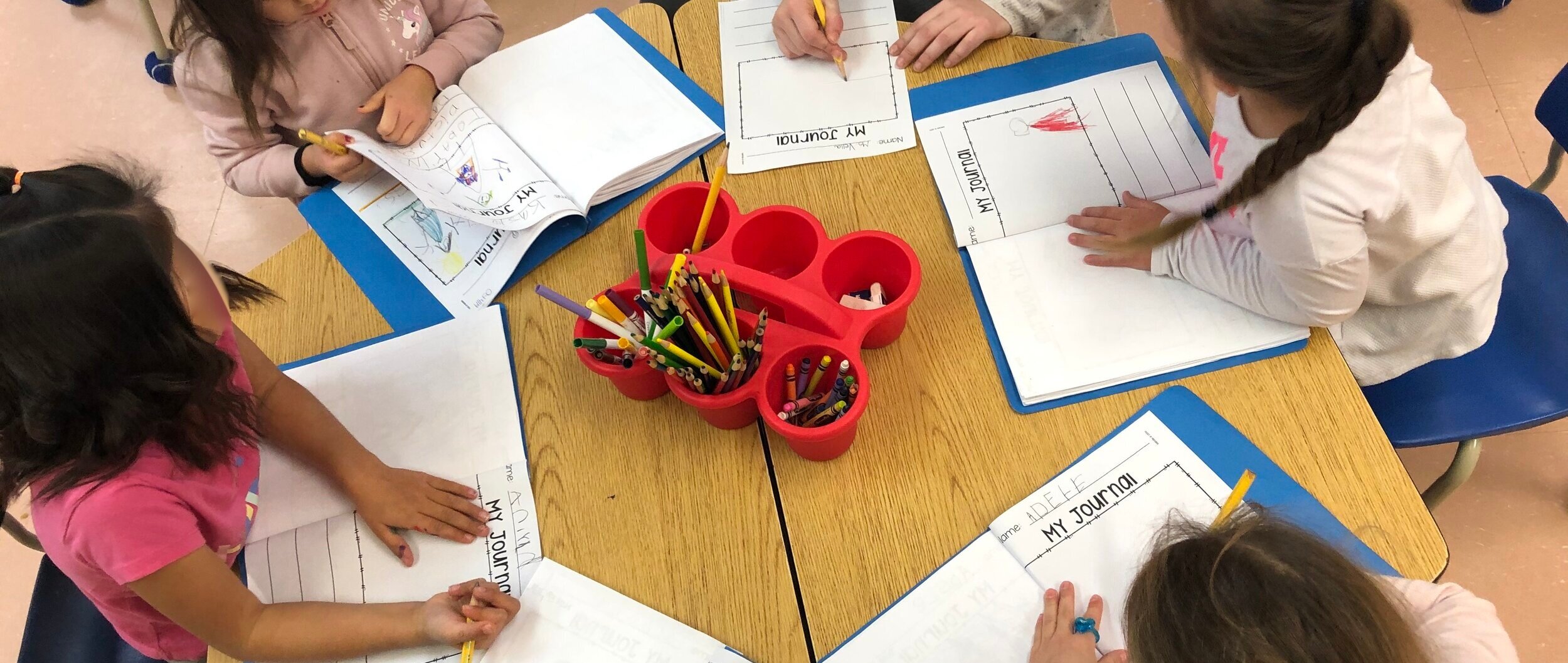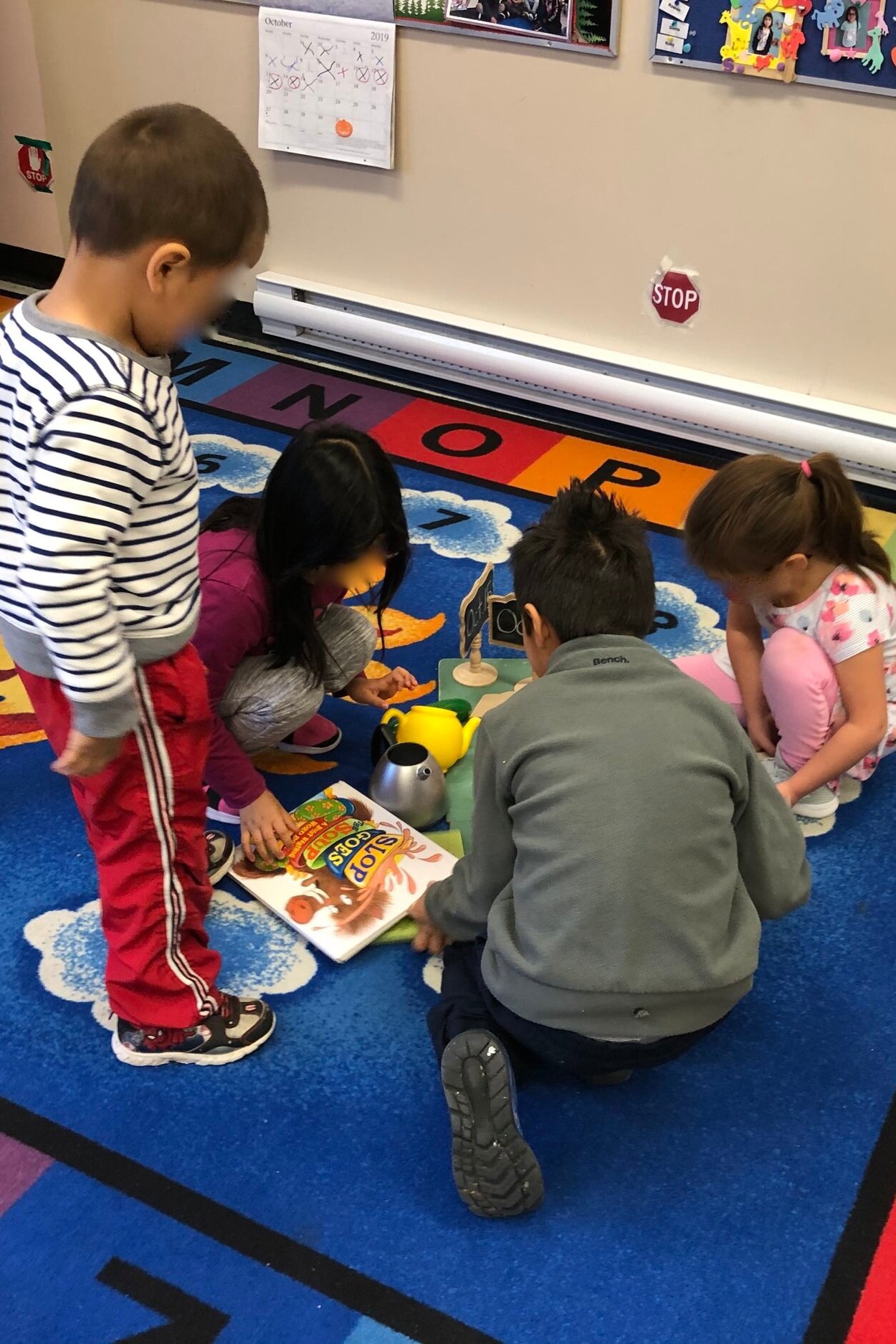
Demonstrating Literacy and Mathematics Behaviours
Demonstrating Literacy and Mathematics Behaviours – “Through play, children develop a wide vocabulary and improve communication skills. Play helps children to think critically, respect different perspectives and process various kinds of information, including mathematical thinking and reasoning. Children use mathematical thinking to make sense of the world. They see patterns, spatial relationships, measurement and quantity, and communicate their understanding of this to others. Children develop a richer vocabulary in all areas, including mathematics, which will help them communicate their thinking and reasoning with confidence.”
What does it look like at home?
Supporting your child’s reading and writing
Make reading fun!
Cuddle up and read. Quiet times together are opportunities to bond and read. Put some excitement into your voice. As you go, explain any new words or ideas. Talk about the pictures. We want reading to be fun, not a chore. Don’t worry about flash cards – just spend more time reading together.
Be a reading/writing role model. You need to read and write in front of your children. When your children see you reading, they will want to imitate you and will see reading and writing as a fun family activities.
Make writing a part of your day. Make writing a part of your day – write letters to family and friends with your child. Encourage them to write down their ideas and stories (as best they can).
Supporting your child’s mathematical thinking
Math should be fun!
When children feel positive and successful about anything, they are more likely to stick with it and to want to incorporate those things into their lives..
Talk and movement help with counting. When children are learning to count, they like to touch, point to and move objects as they say the number aloud – so encourage them and find different objects to count throughout your home.
Organize household items. Encourage your child to organize their toy or household objects into some type of order (e.g., taller/shorter, shape, volume, colour etc.).
Games can be great learning tools. Board games or card games are a fun way to practice mathematical thinking.
Activities
Drawing on a White Board
Use a whiteboard and have your child draw, write numbers, letters, their names, or anything they want to create. You can use regular white boards, and if you don’t have one they are often available at the dollar store along with white board markers. This is an easy low waste activity because your child can reuse the whiteboard to create a variety of things.
Reading Together
Reading together is an incredible way to promote an interest in literacy and to develop cognitive skills. When reading with your child you can ask different questions that will promote critical thinking and engage your child in new ways. Have your child make predictions on what will happen based on the pictures, or what was read so far. Discuss the traits of the characters, the colours and shapes they see. After reading a story together you can have your child create some art to represent the story, or they can add to the story themselves. There are multiple ways that reading can engage your child. Having your child listen to the story is also good so they can work on their listening skills!
Fruit + Veggies Stamping
Fruit and vegetable stamps are a fun way to create art with your child by using everyday foods. You can simply cut the fruit or vegetable and use the natural shapes or patterns they create, or you can carve out designs into the foods and allow your child to explore using the shapes you have carved. This activity promotes understanding of shapes and patterns as well. You can click on the title above and it will bring you to a video example on what this activity can look like.
Board Games Outside
Recreate a family fun board game outside using chalk to engage your child in outdoor play. When clicking on the link, you will see an example of snakes and ladders. This can be a fun activity that prompts creativity, works on design development, and teaches children on how to play well with others.
Overall Expectations:
1. communicate with others in a variety of ways, for a variety of purposes, and in a variety of contexts.
3. identify and use social skills in play and other contexts.
4. demonstrate an ability to use problem solving skills in a variety of contexts, including social contexts.
7. participate actively and regularly in a variety of activities that require the application of movement concepts.
8. develop movement skills and concepts as they use their growing bodies to move in a variety of ways and in a variety of contexts.
10. demonstrate literacy behaviours that enable beginning writers to communicate with others.
14. demonstrate an awareness of the natural and built environment through hands-on investigations, observations, questions, and representations of their findings.
15. demonstrate an understanding of numbers, using concrete materials to explore and investigate counting, quantity, and number relationships.
20. apply the mathematical processes to support the development of mathematical thinking, to demonstrate understanding, and to communicate thinking and learning in mathematics, while engaged in play-based learning and in other contexts.
Natural Measuring Tools
Have your child gather different items or materials outside (dandelions, sticks, rocks, etc), and then have them use them as measuring tools to show the different lengths and widths of the items. This is a great activity to engage in mathematical literacy, by talking about different items in relation to measurement. You can use blocks, a ruler, or other items to then compare the materials from outside. If you click on the link of this activity title, you will see an example of a dandelion being used to show a measurement alongside blocks. Engage your child by asking prompting questions, and counting how many blocks (or other measurement tools) are equivalent to the outdoor material.
Overall Expectations:
1. communicate with others in a variety of ways, for a variety of purposes, and in a variety of contexts.
2. demonstrate independence, self regulation, and a willingness to take responsibility in learning and other endeavours.
4. demonstrate an ability to use problem solving skills in a variety of contexts, including social contexts.
14. demonstrate an awareness of the natural and built environment through hands-on investigations, observations, questions, and representations of their findings.
15. demonstrate an understanding of numbers, using concrete materials to explore and investigate counting, quantity, and number relationships.
16. measure, using non-standard units of the same size, and compare objects, materials, and spaces in terms of their length, mass, capacity, area, and temperature, and explore ways of measuring the passage of time, through inquiry and play-based learning.
17. describe, sort, classify, build, and compare two-dimensional shapes and three-dimensional figures, and describe the location and movement of objects, through investigation.
20. apply the mathematical processes to support the development of mathematical thinking, to demonstrate understanding, and to communicate thinking and learning in mathematics, while engaged in play-based learning and in other contexts.
28. demonstrate an awareness of their surroundings.
Kindergarten Expectations:
○ (2) Demonstrate independence, self regulation, and a willingness to take responsibility in learning and other endeavours.
(9) Demonstrate literacy behaviours that enable beginning readers to make sense of a variety of texts.
(10) Demonstrate literacy behaviours that enable beginning writers to communicate with others.
(18) Recognize, explore, describe, and compare patterns, and extend, translate, and create them, using the core of a pattern and predicting what comes next.
(21) Express their responses to a variety of forms of drama, dance, music, and visual arts from various cultures and communities.
(22) Communicate their thoughts and feelings, and their theories and ideas, through various art forms.
(23) Use problem-solving strategies, on their own and with others, when experimenting with the skills, materials, processes, and techniques used in drama, dance, music, and visual arts.
(30) Demonstrate an awareness of themselves as dramatists, actors, dancers, artists, and musicians through engagement in the arts.
(31) Demonstrate knowledge and skills gained through exposure to and engagement in drama, dance, music, and visual arts.
Kindergarten Expectations:
(1) Communicate with others in a variety of ways, for a variety of purposes, and in a variety of contexts.
(9) Demonstrate literacy behaviours that enable beginning readers to make sense of a variety of texts .
(10) Demonstrate literacy behaviours that enable beginning writers to communicate with others.
(11) Demonstrate an understanding and critical awareness of a variety of written materials that are read by and with their educators (or parents).
(13) Use the processes and skills of an inquiry stance (i.e., questioning, planning, predicting, observing, and communicating.
(15) Demonstrate an understanding of numbers, using concrete materials to explore and investigate counting, quantity, and number relationships.
(21) Express their responses to a variety of forms of drama, dance, music, and visual arts from various cultures and communities.
(22) Communicate their thoughts and feelings, and their theories and ideas, through various art forms.
(27) Recognize bias in ideas and develop the self-confidence to stand up for themselves and others against prejudice and discrimination.
Kindergarten Expectations:
○ (18) Recognize, explore, describe, and compare patterns, and extend, translate, and create them, using the core of a pattern and predicting what comes next.
○ (20) Apply the mathematical processes to support the development of mathematical thinking, to demonstrate understanding, and to communicate thinking and learning in mathematics, while engaged in play-based learning and in other contexts.
○ (30) Demonstrate an awareness of themselves as dramatists, actors, dancers, artists, and musicians through engagement in the arts.
Cereal Box Jigsaw Puzzle
Create your own jigsaw puzzle at home with a cereal box (or any other box will do)! Begin by cutting or breaking the box down so it is flat. Then, have yourself or your child cut out different parts of the box. If you want to stick to a similar pattern that is okay, but don’t be afraid to explore different sizes and shapes. Afterwards, you have a super quick and easy jigsaw puzzle for your child to piece together. An alternate and creative aspect could be to have your child draw or design their own puzzle on the cardboard side of the box, and then proceed as usual to have a different puzzle outcome. This activity promotes mathematical skills by having your child explore different shapes, and piecing it together to see how the shapes create a uniform picture or design.
Overall Expectation:
1. communicate with others in a variety of ways, for a variety of purposes, and in a variety of contexts.
2. demonstrate independence, self regulation, and a willingness to take responsibility in learning and other endeavours.
4. demonstrate an ability to use problem solving skills in a variety of contexts, including social contexts.
13. use the processes and skills of an inquiry stance (i.e., questioning, planning, predicting, observing, and communicating.
16. measure, using non-standard units of the same size, and compare objects, materials, and spaces in terms of their length, mass, capacity, area, and temperature, and explore ways of measuring the passage of time, through inquiry and play-based learning.
20. apply the mathematical processes to support the development of mathematical thinking, to demonstrate understanding, and to communicate thinking and learning in mathematics, while engaged in play-based learning and in other contexts.
Sponge Bullseye
This interactive outdoor activity can be done with a few simple materials. All you will need is chalk and a sponge. Begin by drawing a few circles of different shapes on the sidewalk or driveway, to create a bullseye. Then, decide what each circle is worth. If you want to keep the numbers lower, then simple addition can be done during this activity. Afterwards, use sponges (or rocks), to toss into the different circles. Challenge your child by having them stand at different distances, and then explore math concepts by thinking about adding, through the creation of sized shapes, or pattern making with the bullseye. Click the link of this activity title to see an example of this activity.
Overall Expectations:
1. communicate with others in a variety of ways, for a variety of purposes, and in a variety of contexts.
3. identify and use social skills in play and other contexts.
4. demonstrate an ability to use problem solving skills in a variety of contexts, including social contexts.
7. participate actively and regularly in a variety of activities that require the application of movement concepts.
8. develop movement skills and concepts as they use their growing bodies to move in a variety of ways and in a variety of contexts.
15. demonstrate an understanding of numbers, using concrete materials to explore and investigate counting, quantity, and number relationships.
20. apply the mathematical processes to support the development of mathematical thinking, to demonstrate understanding, and to communicate thinking and learning in mathematics, while engaged in play-based learning and in other contexts.






